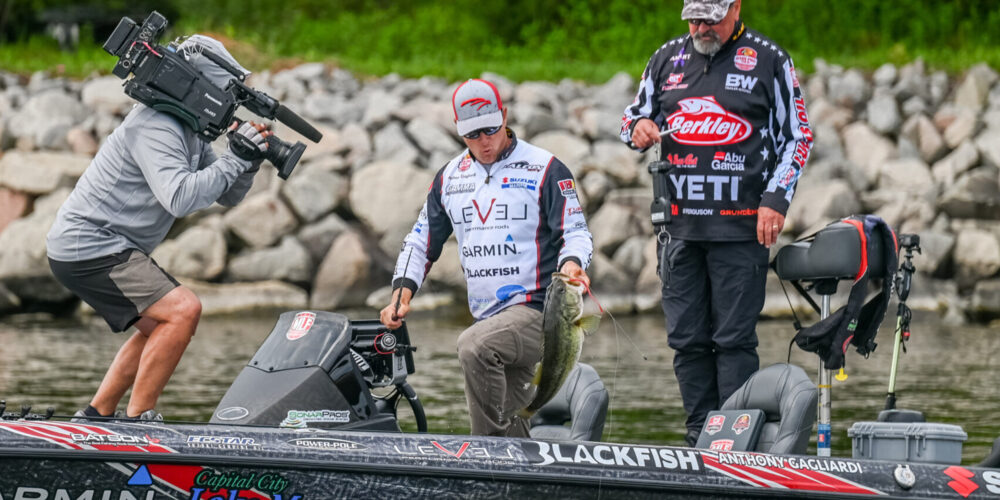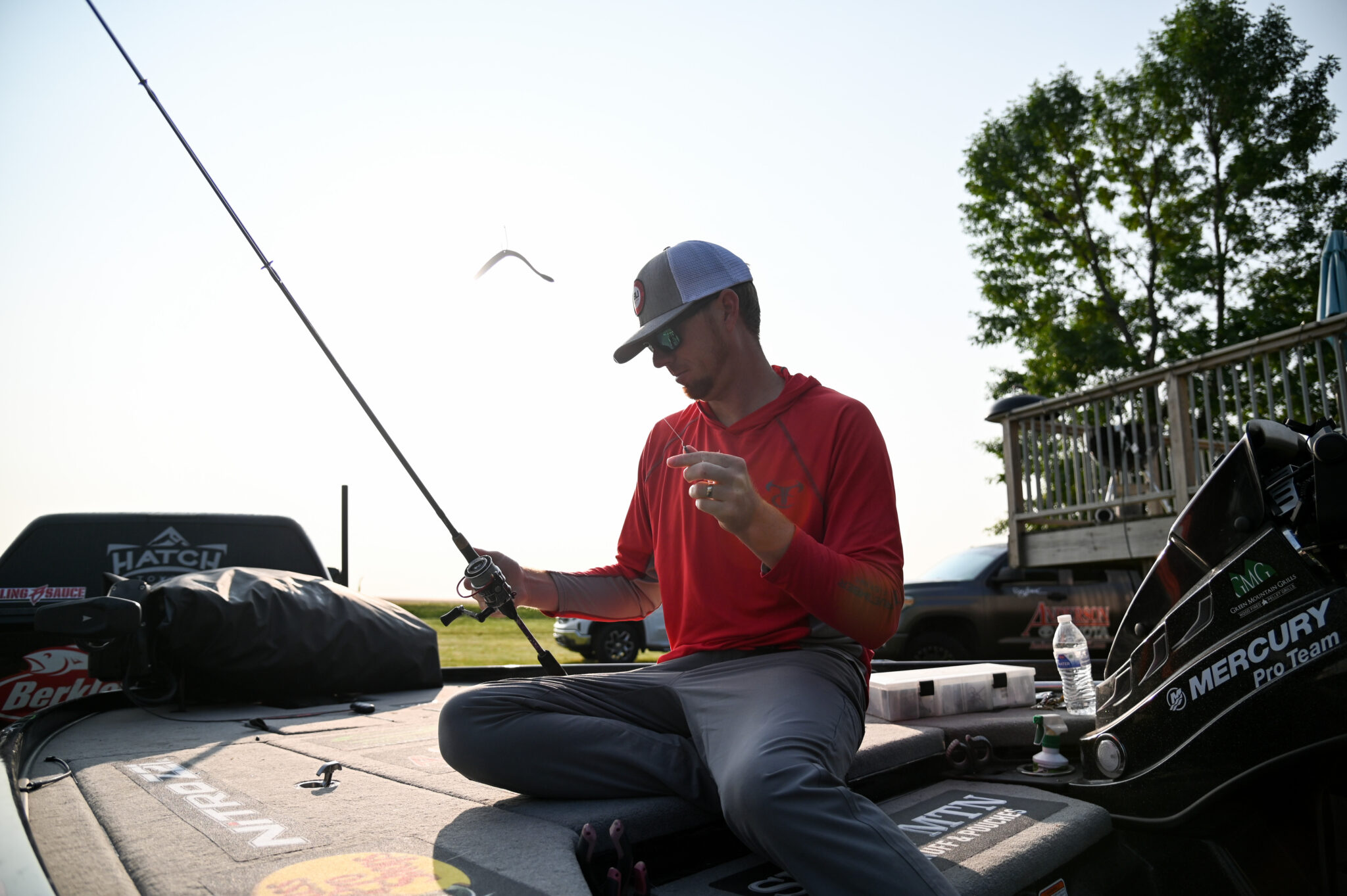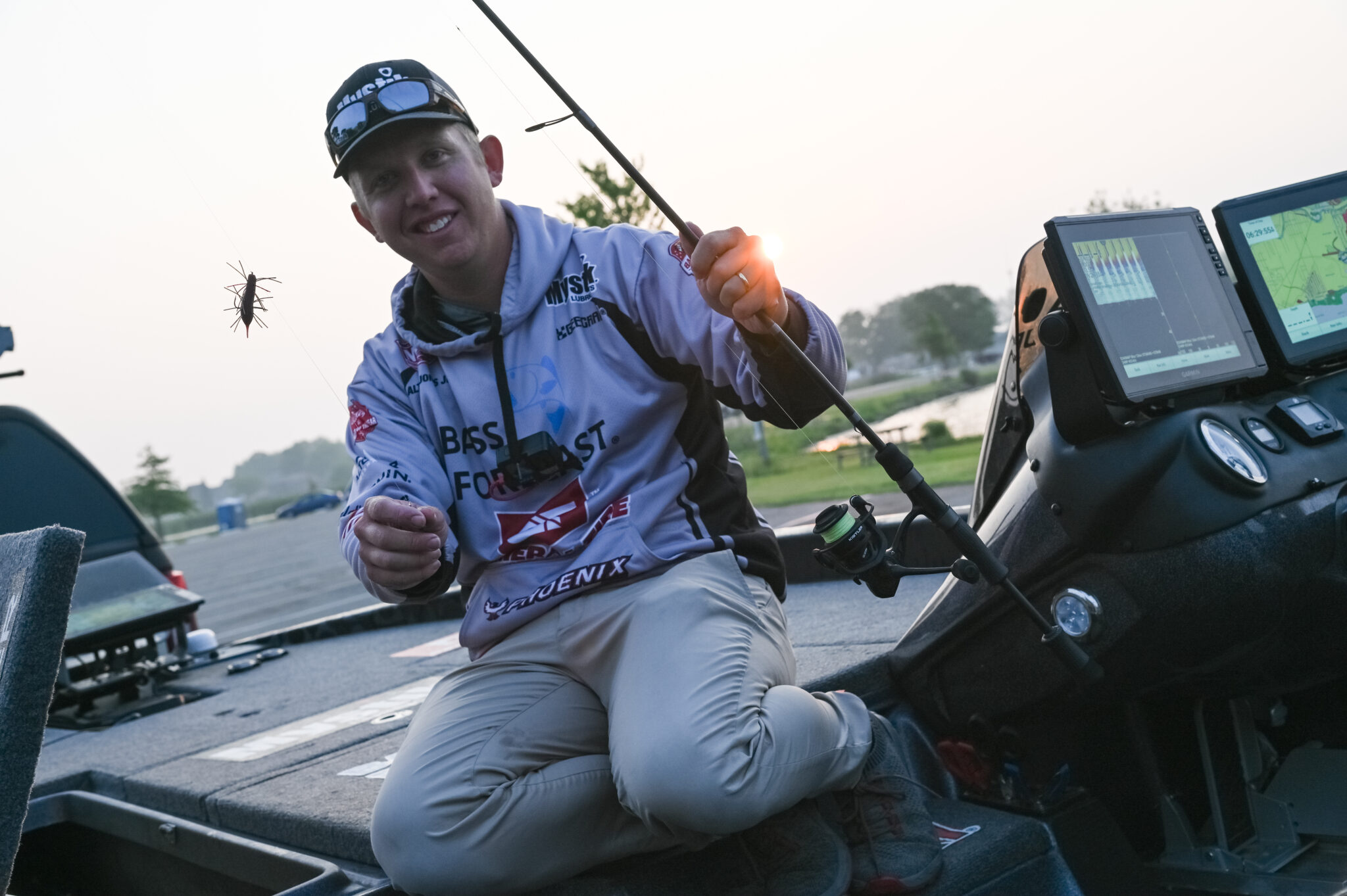2023: The year of the drop-shot?
Other, newer finesse presentations might have made more headlines, but no technique accounted for more Bass Pro Tour success than the old faithful drop-shot in 2023

As usual, the 2023 tournament season shone a spotlight on several new ways to fool bass into biting. Swimbaits like the Berkley CullShad played even on fisheries not typically known for producing lunkers. Ultra-dense, soft-plastic “scat baits” such as the Yamamoto Yamatanuki started to garner mainstream chatter. The headliner, of course, was the emergence of Damiki rigging/mid-strolling soft-plastic minnows like the Rapala CrushCity Freeloader Jacob Wheeler used to win Bass Pro Tour Stage Four at Lake Guntersville.
But as much as those techniques captured anglers’ curiosity, tournament results leave no doubt that a familiar standby remains king.
No technique accounted for more wins or Top-10 finishes on the Bass Pro Tour in 2023 than the humble drop-shot. In fact, it wasn’t close. A drop-shot earned a mention from at least one of the Top 10 finishers at every BPT event except Stage One at the Kissimmee Chain. It served as the primary tool for four of the nine winners. It even swept the Top 10 at Stage Six on Lake St. Clair, with every Championship Round angler attributing the bulk of their success to the technique.
This article originated as a rundown of the top tournament baits in 2023, but the dominance of the drop-shot couldn’t be ignored. Three masters of the technique explained why it has become more effective than ever and even revealed a few new tweaks worth incorporating into your drop-shot arsenal in 2024.
A tool for every situation
It’s not exactly news that a drop-shot gets bit. At this point, just about anyone who fishes for bass understands its effectiveness when the fishing gets tough.
Still, many anglers place limitations on the rig: It’s only for clear water; it primarily catches small fish; it requires light line and small soft-plastics; it’s a break-glass-in-case-of-emergency option when all else fails.
As proven by the top BPT performers, if that’s your mindset, you’re missing out.
During the 2023 campaign, Arizona native Josh Bertrand used a drop-shot both to catch enough lunker largemouth in 5 to 8 feet of water at Louisiana’s Caney Creek Reservoir to qualify for the General Tire Heavy Hitters Championship Round and to finish among the Top 10 on St. Clair, where he targeted offshore smallmouth.
“It works everywhere,” Bertrand said. “You can rig a drop-shot worm weedless and throw it around heavy cover, and then you can nose hook it and fish it around smallmouth. This time of year, out here in Arizona, I use it in 30 to 40 feet of water.”

Fellow BPT pro Anthony Gagliardi urged anglers to remember that the drop-shot is simply a means of presenting a soft-plastic bait. Line size, weight, hook size and style and the lure itself can all vary based on the conditions at hand. As a result, anglers can show bass the natural action provided by a drop-shot, with the bait separated from the weight, in just about any scenario.
“There’s a lot of different stuff you can do with it, and I think a lot of people just pigeonhole the drop-shot as a 4-inch finesse worm, and it’s for super clear water when it’s hard to catch ‘em,” Gagliardi said. “That’s not the case.”
His win at Stage Three on Lake Murray provided perhaps the strongest testament to what can happen when you think outside the traditional drop-shot box. With the rest of the field either fishing shallow for spawners or using reaction baits to chase bass feeding on blueback herring, Gagliardi targeted those same herring-eaters with a 6-inch, straight tail worm on a drop-shot — not exactly a typical herring spawn offering. The result: 47 pounds, 12 ounces over the final two days, including an 8-pounder — the biggest bass of the event.
Gagliardi’s Murray masterclass also disproved drop-shot misconception No. 2: It’s just a numbers technique. Alton Jones Jr. doesn’t believe there’s such a thing as a “numbers bait.” In his mind, the bite-getting ability of the drop-shot actually improves anglers’ odds of connecting with a big one, especially a bass that has seen plenty of other lures through the years.
“When you’re generating enough bites, your statistical odds of catching a big one just go up,” Jones explained. “I feel like, especially as pressure has gotten to these fish, just being able to generate a number of bites to help yourself statistically to get a big bite is really key.”
New twists on a familiar technique
Bertrand, Jones and Gagliardi all do the bulk of their drop-shotting with finesse worms. The latter two said a hand-poured worm like the Roboworm Straight Tail Worm is their bait of choice, while Bertrand’s go-to is the Berkley PowerBait MaxScent Flat Worm. Those are perhaps the two most popular drop-shot baits on the market for a reason: They work.
That said, the drop-shot has caught on nationwide in part because anglers continue to experiment with different baits. That’s starting to show up in tournament results, particularly on northern smallmouth waters.
The Flat Worm remains king among smallmouth drop-shot offerings, but with so many anglers using the rig to target brown fish in and around the Great Lakes, creativity can be rewarded. Minnow-style baits, paddle-tail swimbaits, soft-plastic craws and Ned worms have all produced high finishes on drop-shots in recent years.
Jones has gotten more creative than just about anyone. At Cayuga, he caught bedding smallmouth drop-shotting a Bellows Gill from Japanese lure manufacturer Geecrack. At St. Clair, he used a Geecrack Imo Kemushi to provoke a few key fish. The stubby worm is part of the aforementioned “scat bait” category but stands out thanks to the strands of skirt material protruding from its body.
“I’m doing that on really pressured fish,” Jones explained. “Those are usually not my first attempts at lures. … But when you’re around pressured fish with forward-facing sonar and you can see that they’re not committing, trying those different baits is key.”
It’s not just in smallmouth fisheries where experimenting with drop-shot baits can pay dividends. If you have confidence in a soft-plastic bait, Gagliardi said, try it on a drop-shot. For instance, he fishes the same fluke-style minnows that he rigs weightless during the spring and fall in the Carolinas on a drop-shot during the colder months.
“I’ll put a white fluke on it,” he said. “The weight just gets it down there. Then once it’s down there, I’m able to fish a weightless fluke 20, 30 foot deep.”
Regardless of what plastic he’s using, Jones has taken to threading his drop-shot baits onto straight-shank hooks with a keeper, particularly when targeting smallmouth or spotted bass. He prefers a threaded presentation to the more traditional nose-hook setup because he believes it results in a better hookup-to-land ratio and improves the durability of his baits.
“When we fish places like Lake St. Clair where there’s large numbers of fish being caught, I’m saving baits throughout the day by threading it and supergluing it,” Jones said. “Also, I can be really quick. Like, I catch a fish, if it’s not the size I need or it’s not the one I want, I can let that fish go immediately and my bait doesn’t have to be re-rigged. I’m just back fishing.”

Better than ever
The versatility of drop-shotting is only part of the reason it emerged as such a dominant weapon last season. The other, bigger factor: forward-facing sonar.
Having the ability to pinpoint fish has eliminated the biggest downside of the drop-shot, its speed (or lack thereof). What used to be a painstaking way to present a bait can now quickly and precisely target individual bass.
All three of Bertrand, Gagliardi and Jones praised the drop-shot for its efficiency. Since the weight doesn’t hinder the bait’s action, a drop-shot can be fished with heavier weights than, say, a shaky head or Neko rig, allowing it to quickly reach a fish seen on live sonar. The fact that the lure can then be twitched and wriggled in place helps generate bites from bass that need to be convinced.
“You can throw a heavy sinker on it, it’s got a fast rate of fall,” Jones said. “For it being a slow presentation, you can cover water fast. It’s just incredibly efficient.”
The prevalence of forward-facing sonar also means bass are more pressured than ever. And despite the prolonged popularity of the technique, the drop-shot remains one of the best ways to fool wary fish, even in the western waters where it’s been a staple for more than two decades.
“It’s the one technique that the fish really don’t get super keen to over time,” Bertrand said. “These fish out west have seen it for 25 years, and it’s still oftentimes the best way to catch educated fish.”
With fishing pressure not expected to dwindle anytime soon, look for the drop-shot to continue to play an outsized role on tour. Other finesse techniques might emerge and excel in specific situations — like mid-strolling for suspended fish or a wacky rig around overhanging cover — but Bertrand doesn’t see the drop-shot getting dethroned any time soon.
“If I meet a 10-year-old kid and they’re getting into bass fishing and they want to start catching fish, ‘hey dude, learn how to drop-shot,’” he said. “I would say 75% of the country, drop-shotting is probably the technique that can put more fish in the boat than anything.”